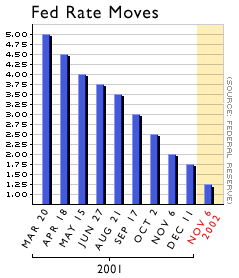NEW YORK (CNN/Money) -
If you've used a computer, read a newspaper, watched TV or lived in the vicinity of a billboard in the past several months, you've likely heard what a super-fantastic thing low interest rates are.
To borrow a phrase from Porgy and Bess: It ain't necessarily so.
Last week, the Federal Reserve slashed its target for the federal funds rate, an overnight bank lending rate, by an aggressive half a percentage point to 1.25 percent, the lowest level in 40 years.

Rate cuts are generally good news for the economy because they encourage banks to lower their interest rates, making it easier for people to borrow money, which they turn around and spend on new PlayStations, Explorers and other stuff.
But beneath the cheers for last week's rate cut, if you listened carefully, you could hear the groans of retirees and other people who live on interest income.
"In the last year, the consumer sector had $1.1 trillion of interest income and $600 billion of interest expense," said former Fed economist Lacy Hunt, now chief economist at Hoisington Investment Management. "In the aggregate, the consumer is a net creditor, not a net debtor."
Translation: when consumers -- usually older families who've paid off their mortgages -- see interest rates fall, it means their interest incomes fall.
Keeping money in consumers' hands is critical to an economy struggling mightily to recover from a recession that began in March 2001, since consumer spending makes up more than two-thirds of the U.S. economy.
| Living with low rates
|

|
|
|
|
Of course, lower rates help younger families, who are more likely to be debtors, balancing out some or all of the pain felt by families who are "net creditors."
Low mortgage rates, for example, fueled an unprecedented refinancing boom that enabled homeowners to cut their mortgage payments and borrow more against their home equity, which has swollen like a balloon -- or a bubble, if you will -- as demand for houses has soared.
But the refinancing boom has drawbacks, too. For one thing, any institution that holds a mortgage loan is going to get a lower rate of return. And if that institution's own debt is at fixed rates and cannot be "called," or refinanced, its net income could shrink.
Mortgage Bankers Association chief economist Doug Duncan said his industry wouldn't mind at all seeing mortgage rates, which have been at or near record lows for several months, rise a full percentage point to about 7 percent.
"If rising rates are a function of an increase in real household income and growing employment, then that's an increase in the pool of potential buyers and a strengthening of the resources of homeowners, and that's a good thing," Duncan said.
Many banks have shucked off the risk of falling rates by selling their mortgages to other firms, who turn the loans into mortgage-backed securities. But all they've done is transfer the risk to the people and institutions -- including, possibly, you -- who buy those securities.
According to Jim Bianco, fixed income analyst and president of Bianco Research in Chicago, 45 percent of the U.S. bond market is tied up in "callable" securities, bonds like mortgage-backed securities that can be taken away at the issuer's whim.
"If interest rates fall, companies or agencies or homeowners have the right to refinance their debt, to call those bonds in or refinance and get a new mortgage at a lower rate," Bianco said, "and the bondholders are then stuck with having to give those high-yield bonds away and are forced to go out and buy lower-yield bonds."
The low-interest-rate environment has also encouraged lots of credit-risk borrowers to come out of the woodwork looking for loans, and they've managed to find banks willing to make those loans.
Combined with a sluggish economy and a stagnant job market, many of these people have had a hard time paying off their new loans, and rates of mortgage delinquencies and defaults have climbed, while the personal bankruptcy rate is at a 40-year high.
"This is the open bar syndrome, in which many people admit that they tend to drink more when they go to functions sporting an open bar as opposed to when they go to a restaurant and have to pay for every individual drink they order," said Anthony Chan, chief economist at Banc One Investment Advisors.
In a more general sense, Chan and other economists pointed out, rock-bottom rates also make it more difficult for the Fed to goose the economy by cutting rates, since big, dramatic cuts could leave the Fed clicking an empty gun, forcing it to resort to more exotic measures.
Still, few economists think the Fed should actually raise interest rates to counteract these drawbacks, considering the sluggishness of the economy and growing fears about the possibility of deflation, a dismal economic situation in which prices fall uncontrollably, hurting corporate profitability, production and employment.
"Raising rates would be an egregious mistake," said Hunt of Hoisington Investment Management. "There were a couple of instances in Japan where the Bank of Japan did raise rates to help the income of pensioners, and it had negative consequences."

|

